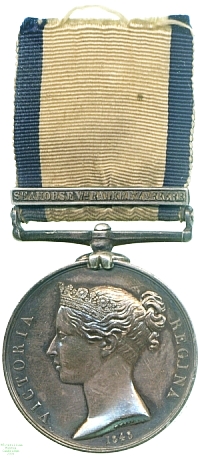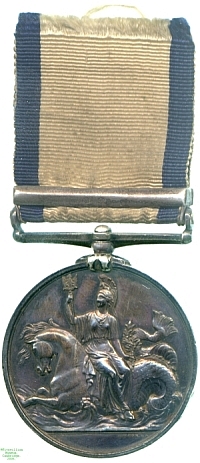
Obverse, a bust of Queen Victoria

Reverse, Britannia with a trident seated sideways on a seahorse

Obverse, a bust of Queen Victoria |

Reverse, Britannia with a trident seated sideways on a seahorse |
Just as in 1848 the extensive land campaigns of the Napoleonic Wars and the other conflicts of the pre-Victorian era were recognised by the issue of the Military General Service Medal, those serving in the Navy at the time were recognised with the Naval General Service Medal. As with the Army equivalent and the East India Company's related award, many of the battles for which the medal was awarded had been fought so long ago that few if any claimants survived.
In addition, bars were awarded for many actions whose significance and size were, despite the heroism displayed by those involved, relatively minor. The result was that many of the bars were issued in tiny numbers, with some combinations all but unique, and the medals command a very high price among collectors because of this rarity and individuality. This in turn, along with the manufacture in most cases of more bars than were eventually issued, has led to the `improvement' of many common awards where recipients' names are shared with those present at `rarer' battles. The medal also shares with the Military General Service and Army of India Medals the oddity that Queen Victoria, whose portrait they bear, was not the ruler under whom the battles for which it was awarded were fought.
In the complicated dance of international politics around the fringes of the Napoleonic Wars, the Ottoman Empire took the opportunity afforded by Napoleon I's defeat of Tsar Alexander I's Russia at the Battle of Austerlitz in 1805 to occupy several principalities contested with Russia, with French support. This ranged Britain against the Ottoman Empire, a state which continued even after Russia had been forced to sign the Peace of Tilsit with France in 1807, by which time a series of defeats at Russian hands had much reduced the Turkish navy. This may explain why when two of its remaining frigates encountered the 42-gun frigate HMS Seahorse on 6 July 1808, one, the Ali Fezan, immediately beat a retreat. The other, Badere Zaffer, however fought for the next 12 hours and surrendered only the next morning, dismasted and uncontrollable. The Seahorse had taken less than a twentieth of her casualties.
This medal was one of 35 issued with the bar for this battle, and was awarded to Thomas Jenkins. His service aboard Seahorse has been verified, and the Medals Roll confirms the award of this piece to him. Lester Watson purchased the medal in a New York auction during 1927.